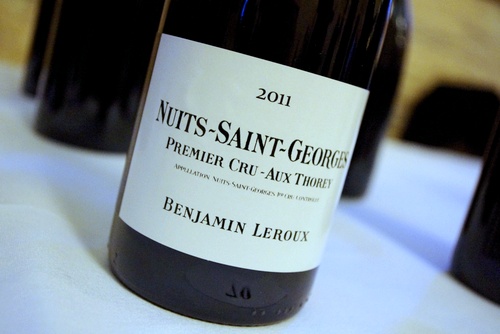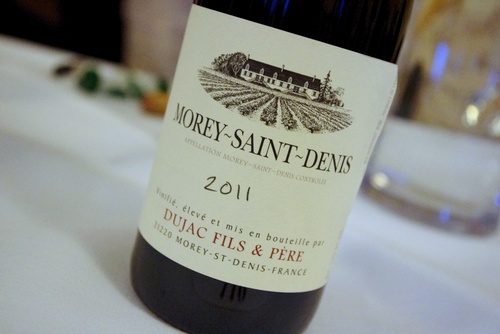This week is Burgundy en primeurs, in London. Unlike the Bordelais, the Burgundians wait a bit longer before showing cask samples (15 months after vintage, versus 6), and travel to do so. It has developed into quite a circus, with 30 or so tastings (I haven’t counted) over a week and a bit, many with quite a bit of overlap.
This brings visitors to town. I spotted Michel Bettane and Jeannie Cho Lee among the crowd at yesterday’s Berry Bros & Rudd tasting. Many of the UK press spend the whole week tasting.
I chose to attend just one tasting. It’s not because I don’t love Burgundy (it’s possibly the most interesting fine wine region of all because of the terroir connection, and two compelling grape varieties). It’s because I have to earn a living, I’m not recognized as a go-to Burgundy expert, and so I can’t justify a week getting to know these baby wines in depth. To be a Burgundy expert, you have to devote most of your professional life to the region, because it is so complex and the vintages are all so different – and most producers make a dozen or more wines each year.
It’s also because these are tastings of cask samples. Now from the cask directly, tasting can be quite interesting. But there’s only a limited amount of information you can get from a sample that has been taken from cask, bottled (usually with massive oxygen pick-up), and then shipped to London. All barrels differ, anyway, so it needs to be borne in mind that the impressions of the wines are simply fleeting, and possibly misleading ones at this early stage, under these conditions.
So beware critics who are writing veritable essays on these young wines, and affixing precise scores to them. It’s for this reason, I won’t be posting notes. But I will share my own impression of the vintage, superficial though it may be.
First, it’s a better year than you might expect from the vintage conditions. One grower told me (with admirable honestly) that 2011 was a miserable year in Burgundy, with very few wines being picked above 12% potential alcohol. It rained for two months before the harvest. This grower didn’t make a single wine above 12% alcohol, but he was one of the very few not to have chaptalized. It was a good year indeed for sugar salespeople.
I tasted some nice whites, with the standouts being the precise, mineral wines of J-P Fichet.
The reds seemed mostly bright and very pretty, with lovely direct fruit. Some of the more elaborate wines were showing too much wood. These are not big, structured red Burgundies, on the whole, and the more successful wines seem to be the ones that haven’t tried too hard to be what they aren’t.
I reckon it’s a vintage to buy and drink young. Sadly, prices have risen 10-15% since the very good 2010s, which doesn’t make them great value for money. This is partly because 2012 is a very short vintage, with quantities vastly reduced, although where growers succeeded in 2012, word on the street is that the wines are better than the 2011s.
I also heard murmurings that 2011 might be another ladybird vintage, so look out for excessively green wines. I only found one potentially ladybird-affected wine in yesterday’s tasting, but it’s something to bear in mind.
5 Comments on Burgundy 2011 – some impressions



Having just received a price list from an Antipodean supplier, I’d imagine you’ll be seeing 10-15% price increases across the board in 2013. Not surprising giving the cost increases in any other agricultural product, but perhaps surprising more wine journalists haven’t picked up on it. And very pertinent and again often unsaid point about cask samples; always good to make people aware of the parameters within which their reading.
Hi Jamie,
What does a ladybird vintage mean?
Love your blog!
Cheers
For ladybirds, see – http://www.burgundy-report.com/autumn-2008/2004-a-la-coccinelle/
Jamie
Some fair points. But I would add the following:
1. There is no goût de coxinelle in the wines. None whatsoever. Only one critic has identified this and I haven’t met a single grower who agreed, and I reckon I’ve spoken to 200 of them and tasted over 2000 wines.
2. Most Burgundian vintages were chaptalised in the past. That’s not a crime. I’d much rather drink 2011 than high alcohol, sometimes soupy 2003. The freshness of the wines is very appealing.
3. Many of the white wines are already bottle, and some of the reds. There is far less manipulation of samples for the en primeur tastings than there is in Bordeaudx. What you taste in London and Burgundy is pretty much what you will see in bottle.As you say, we are tasting the wines at a later stage.
4. The only way to understand the vintage properly is to go there and talk to people in French, walk though the vineyards, listen, taste honestly and humbly and then provide one’s views.
Your readers might want to consider downloading my report on the vintage (http://www.timatkin.com). Ratings for over 1500 wines. 250 tasting notes. One palate. Advice, not information.
Keep up the good work.
Tim
Jamie,
Having worked the vintage in Morey-Saint-Denis in 2011 I can attest that 2011 was a “ladybird” vintage, at least in Cote-de-Nuits reds. The eight hectare vineyard where I worked experienced high levels of ladybird beetles which warranted a special shaker-table to remove the majority of bugs from the clusters.
Erik